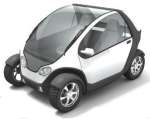Most of what follows was written a few years ago [2020: at least fifteen] but you can get up-to-date information on the latest in less-environmentally-damaging cars at AutoBlogGreen.
Cars – Innovative Designs
GM EV1
The first modern electric car to go on the market from a major manufacturer, the EV1 was a technical tour de force but it was a commercial flop. Or so General Motors claims. If you haven't already, I urge you to see the film Who killed the electric car? in which GM, other car companies, the oil companies, government [particularly the California Air Resources Board (CARB)] and even unquestioning consumers all come in for scathing criticism.
Cynics also claim that electric cars merely transfer the pollution from the car’s exhaust pipe to the electric power station which is often coal-fired. While there is an element of truth in this, I think it is better to have the pollution source centralized so that if a decision is made to clean the air, then it is only done in one place and the effect is immediate. The problem with introducing new pollution controls on cars is that it takes years for older cars without the improvements to be taken off the road. I believe that over 50% of cars on Australian roads are more than 10 years old.
One of its best features is the charging connection which is "inductive" rather than "conductive" like the plugs connected to all the appliances in your house. The advantage is that it is impossible to electrocute yourself when you hold the plug which is shaped like a table-tennis bat. General Motors deserves kudos for having the guts to try but that doesn't help their bottom line or sadly, the air we breathe.
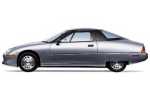
Toyota Prius
Toyota’s hybrid approach of using a gasoline engine to drive a generator, has most of the benefits of lower pollution and greatly reduced fuel consumption over regular cars but without the disadvantage of having to recharge overnight like a pure electric. Now in its third generation, hundreds of thousands have already been sold although before you think too kindly of Toyota bear in mind that they sell a lot more full-size pickup trucks and as Who killed the electric car? noted, the company destroyed its fleet of electric vehicles as soon as CARB buckled and the leases ran out.
This and the other hybrids on the market are parallel hybrids meaning that the electric motor and gasoline engine can power the vehicle together but this leads to frightening complexity. Wikipedia has an extensive article on the car.

The original Toyota Prius sold reasonably well in the US and but has not been available as a hatchback. However, the 2004 model is which makes it perhaps the most desirable vehicle anywhere.
BMW Z13
The picture doesn't show the seating layout which is a shame because this is what makes this show car so interesting. The driver sits in a bucket seat in set in the center while there are passenger seats on either side and set back somewhat. This arrangement means the two back seat passengers have plenty of leg room and the length of the car is reduced. BMW reason that cars normally have only one person in them anyway so the car should be built around the driver. The central position gives the driver a better view, provides better crash protection and also means the car could be sold in left- and right-hand drive markets without modification. The McLaren F1 supercar used the same arrangement but that car is only for very, very rich people while this was intended to be a sporty commuter vehicle for ordinaly folks.
A modified BMW motorcycle engine sits behind and between the two passengers.

BMW Z13 show car. Notice the short distance between the front and rear seats since the two rear seat passengers actually sit to the side of the driver in the center.
BMW Isetta
Three wheels, two seats, an engine and just like your house, a front door! What more could you want?
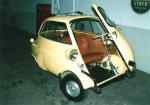
Mitsubishi MUM-500
Another show car, this is great because it is a minimalist car. It weighs next to nothing and so only needs a 500cc engine. I also like the quarter-circle profile and windows that appear to pivot instead of going up and down.

Mitsubishi MUM500
This car is of similar size to the Mercedes Smart car but I think this one is much prettier.
| Year: | 1993 |
|---|---|
| Seating capacity: | 2 |
| Engine capacity: | 500 cc |
| Power: | 30 hp (22 kW) |
| Transmission: | Automatic |
| Length: | 2570 mm |
| Width: | 1395 mm |
| Height: | 1500 mm |
| Weight: | 450 kg |
Smart car
I was pleased to see lots of these during our 2002 trip to France and Holland because they initially didn't sell well. Originally started by the watch company Swatch with Mercedes-Benz having a financial interest, MB finally took over and brought its full engineering expertise to bear before it was brought to market. It is exactly 2500mm long which must make it a joy to park but I wish it were prettier. [Aug07 update: the new model is 2695mm long and it is coming to the US in 2008, though sadly, not the diesel version.]
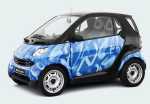
Chrysler CCV
Chrysler threw away convention on how to build a car when they thought about the ideal vehicle for developing nations. This is the Chrysler Composite Vehicle but almost everyone saw it as Chrysler’s China Vehicle when it was shown in 1997. This car does not meet current crash protection requirements for most industrialized countries but the target market is people currently riding motorcycles who have no protection at all and in most of the third world, the roads are lousy and speeds low.
What makes this car revolutionary is that the entire body is made of just 4 plastic mouldings. A conventional small car with a steel body has 80 parts which need to be welded together and painted to minimize corrosion and make it look good. The plastic used on the CCV accepts color pigments so no painting is necessary though it is a matte finish instead of gloss. Eliminating paint alone saves huge expense and worries about solvent emissions.
An air-cooled engine is fitted so the radiator and coolant pump are eliminated, further reducing cost. There is a resemblance to the Citroën 2CV, which should not be surprising since it had similar design goals: be very cheap and suitable for rough roads. Just in case you hadn't noticed, there are two "C"s in CCV, further linking it with the 2CV.

Take a look at the front view and compare with the Citroën 2CV.
Cost Reductions:
- Requires 6.5 hours to build a car vs.19 hours to build a Neon
- Plant investment is less than $300 million, about one-third typical investment for assembly, stamping and engine plants combined
- Eliminates the need for a satellite stamping plant and engine plant
- Minimum number of parts/components (1,100 compared to 4,000 in conventional car)
- Eliminates $350 million in the cost of the paint shop, including regulatory costs
- Tooling costs reduced by 33 percent
- Cost of the composite is less than $3.30 per kilogram ($1.50 per pound). Other types of composites used in automotive are between $11 and $22 a kilogram ($5 and $10 a pound)
| Estimated Fuel Economy: | 4.7 L/100 km/50 mpg city |
|---|---|
| Engine: | 0.8L 2-cylinder, overhead-valve, air-cooled |
| Transmission: | Four-speed manual |
| Frame: | Full-steel |
| Brakes: | Manual disc/drum |
| Suspension: | Independent front and rear |
| Ground Clearance: | 203-mm/8 inches |
| Turning: | 10-meters/33-feet |
| Payload: | 363 kg/800 pounds |
| Curb Weight: | 544 kg/1,200 pounds |
| Parts: | 1,100 |
| 0 - 30 mph: | 6 sec. |
| 0 - 60 mph: | 25 sec. |
| Top Speed: | 115 kph/70 mph |
| Price: | About 10,800 DM ($6,000 U.S. dollars) |
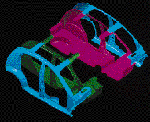
Commuter Cars Tango
The fellow who started this company was sitting stuck in traffic and realized that road capacity would be doubled if we all drove vehicles half the width. This is what hs proposes. It is electric and he wants to make a smash prejudice by giving it fast, even if range is still restricted. The lead-acid batteries are under the floor making it stable despite its narrow width. I wish him every success though I fear that without major backing, he won't be able to pull it off.
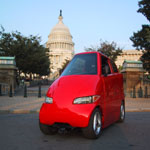
GM Lean Machine
I was so impressed when I read of this but boy have I been disappointed in the more than two decades since [2020: now 37 years!]. Not only was this beauty never brought to market but the cars on the road now are essentially the same in concept—and fuel economy—as those when the article was written in 1983. I will admit that everything else about them is greatly improved such as emissions, safety, reliability and comfort.
Road & Track article (3MB)
Carver One
[July 2009: Now bankrupt.] It seems that the Dutch have figured out a way to make a tilting 3-wheeler tilt with just input from the steering wheel, unlike the Lean Machine which requires the driver to control the lean by pushing foot pedals. This one appears to be a serious sporting machine but it looks ugly (!!!) and it is expensive so it will never sell in significant numbers.

Venture One
If this ever gets built [July 2009: it probably won't. They changed their name to Pursu Mobility a few months back and pulled down the news/discussion boards so now there is no hint that anything is happening. They were using technology from Carver but now they've gone under.], I want one! As much as I like the Lean Machine, it doesn't look tough or sporty like this does. This would sell if ...
In August 2007 after a long period of silence on their web site, they announced that they had secured $6 million of funding which will presumably get them a nice prototype which they can then use to get the real money required for a factory, dealer network and advertising. The track record of start-up automobile companies in the developed world is basically 100% failure so I wish one of the big four Japanese motorcycle companies or BMW would take this on as they already have the engineering expertise and capital to fully develop it but more importantly, have a dealer network and brand recognition that would make people feel comfortable about buying it knowing they will later be able to get it serviced and that a market will likely exist for second-hand machines.

John Ewan's enclosed motorcycle
Stunningly beautiful. Drop-dead gorgeous. Not actually driveable. I would LOVE to see the mechanicals (including the air conditioner) from a diesel Smart packaged into something looking like this. With a much smaller frontal area (lower air resistance) and lighter weight, 100 miles per gallon should be easily achievable. This would be my favorite car if it were built.

MIT CityCar
More than just a car but intended as a shared-ownership utility to get you to and from mass transit. The architect Frank Gehry had a hand in styling it and it looks beautiful to me.
[2020 update: How A Folding Electric Vehicle Went From Car Of The Future To 'Obsolete' In fact the project seems to have been mismanaged but the basic concept remains sound whereas MIT's more recent idea, the "Persuasive Electric Vehicle" seems absurd to me. In general, motorists will not use something bike-like because it won't keep them dry when it rains, warm when it is cold or cool when it is hot.]
